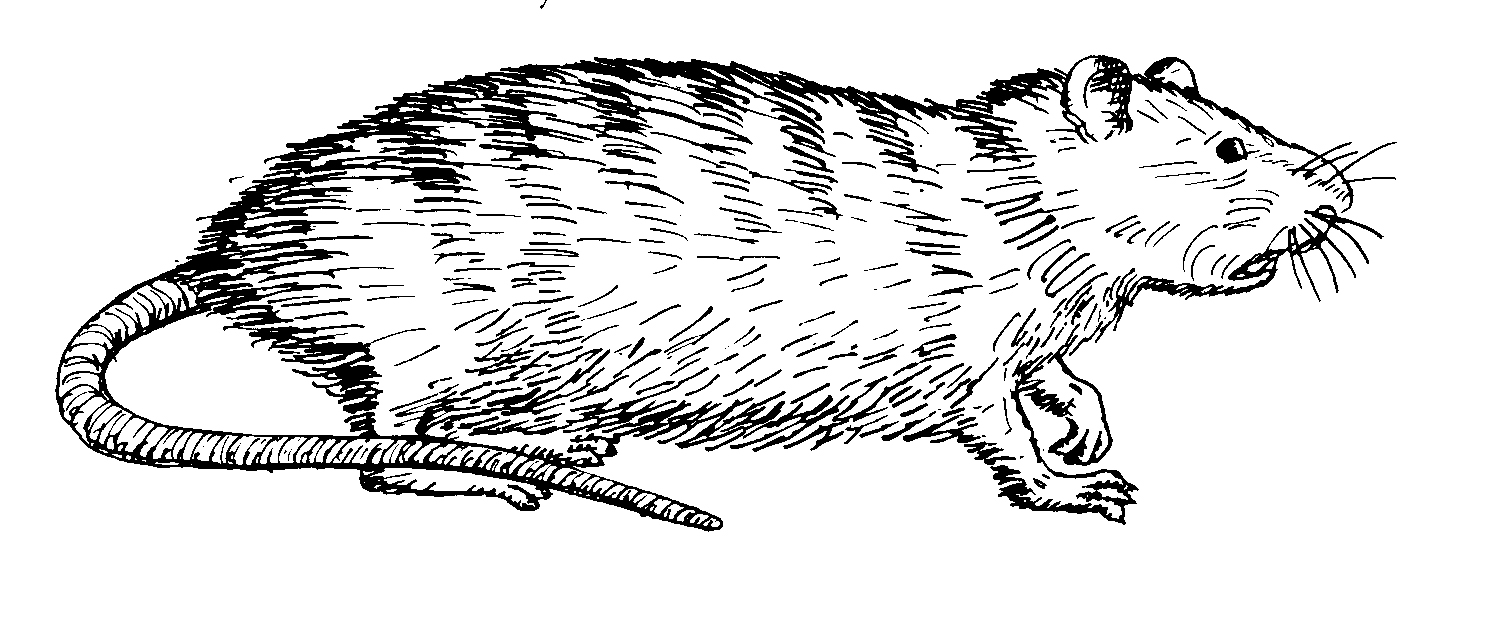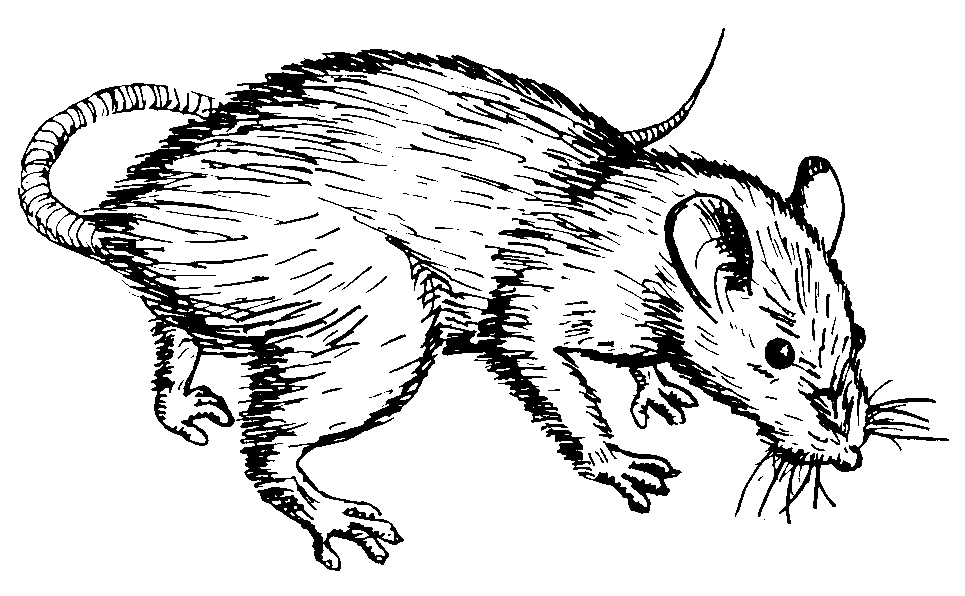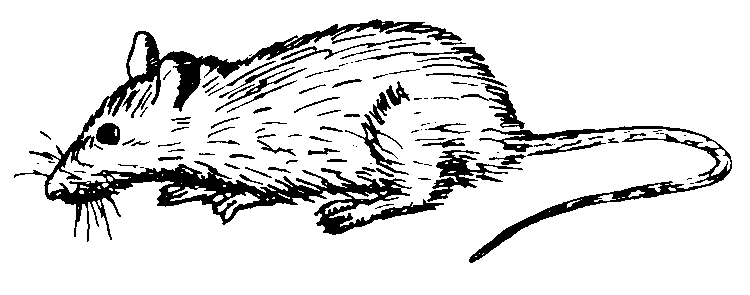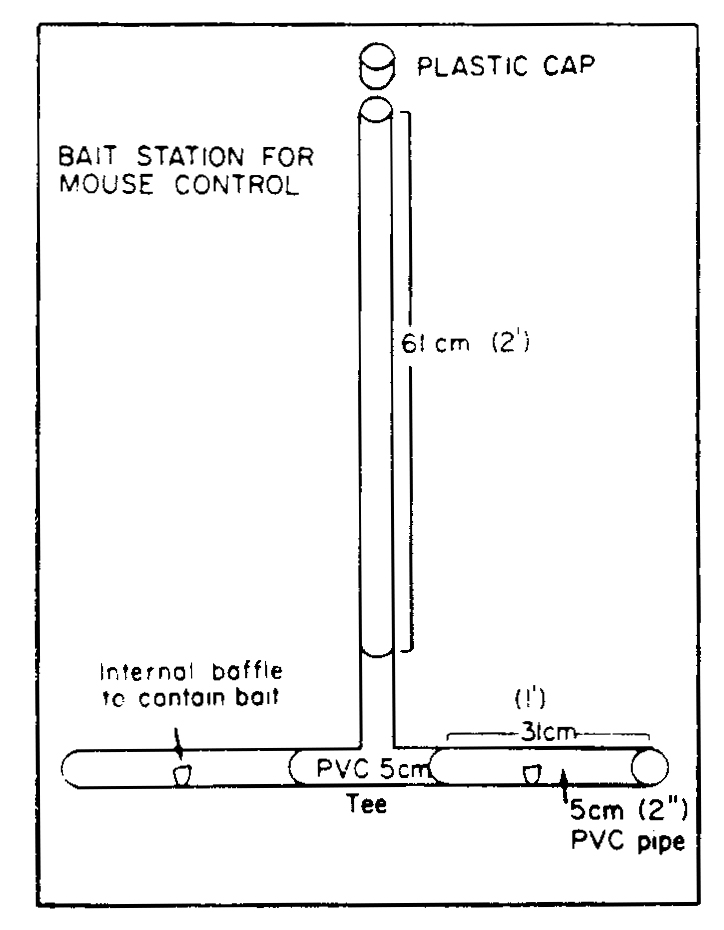Rodent Control in the Poultry House
Rats and mice are unwanted and frequently unnoticed guests in poultry houses. Because of the method of construction design, some poultry houses provide easy access to rodents. Once inside the house, rodents can readily burrow under dry manure, into dirt floors, into deep litter, inside hollow walls, or into insulation in walls and ceilings. Regardless of where rodents live, they can cause a number of different problems that usually cost producers money.
One of the most obvious areas of concern with rodents is feed wastage. All types of rodents eat poultry feed and they waste and contaminate more than they eat. Dollar losses from feed eaten or wasted are difficult to estimate. It has been suggested by some authorities that one rat eats approximately 25 pounds of feed per year. If that daily figure is converted to a yearly estimate and if as many as 200 rats are present (not a heavy infestation for a large poultry house) the yearly loss per house could reach 2.5 tons. If feed cost $175/ton, that cost would be $437.50 or $2.18 per rat. In addition to feed eaten the feed wasted and contaminated significantly increases the loss. With more than one poultry house or with a very heavy infestation the cost would be much higher. Two and a half tons of feed seems like a sizable amount to be losing, but it goes in small amounts throughout the year and is difficult to trace. Some USDA estimates of the actual cost of rats wasting feed and damaging the house and equipment are as high as $25 per rat per year. Compare this with the estimate of $.25 to rid a poultry house of one rat.
Physical damage to the building and equipment is another way rodents can be costly.
Gnawing on support structures, plastic curtains, egg belts, egg elevators with sponge
fingers, and burrowing under walls and concrete walkways causing shifting and cracks
are some ways that damage can occur. Not to be overlooked as a potential problem is
the danger of fire due to rodents chewing insulation on electrical wiring.
Disease problems can also be serious consequences of a rodent infested poultry house.
Rodents can transmit as many as 35 different diseases affecting man and other domestic
animals. Diseases caused by Salmonella species and fowl cholera are those of greatest
concern to poultry producers. Rodents also carry parasites such as lice, fleas, and
mites.
In addition to damage and feed loss rodents can cause high mortality rates and production losses. Rats have been known to kill baby chicks and break and eat eggs, and they may frighten birds by their movements or by noises they create. Research has shown that by reducing the rodent population in poultry houses the bird mortality rate can also be lowered.
Identification: The most effective control measures can be planned only if the kinds of rodents are correctly identified. The most frequently identified rodents are the Norway rat, the Roof rat and the House mouse.
The Norway rat is also sometimes called the Brown rat, Common rat, or Wharf rat. This rodent has a large thick body that reaches a length of 7½ to 10 inches with a tail length of 6 to 8½ inches. The rat varies in color from brown to gray and has a blunt snout, small ears, and small eyes. Droppings are usually capsule – to spindle shaped and are approximately ¾ inch in length.
The Roof rat is sometimes called the Black rat or the Ship rat. It has a slender graceful body and is somewhat smaller than the Norway rat. The head is narrow with a pointed snout, large ears, and large eyes. Roof rat droppings are smaller than those the Norway rat and are spindle to sausage shaped.
The House mouse is small, slender rodent with an average weight of about ½ ounce. The adult mouse will reach a length of between 2½ to 3½ inches. Its features include a pointed snout, large ears, small eyes, and light brown to dark gray fur. Mouse droppings are smaller than those from the rat and are rod-to-spindle shaped.

Figure 1.
Rattus norvegicus
Norway Rat or Common Rat

Figure 2.
Rattus rattus
Roof Rat

Figure 3.
Mus musculus
House Mouse
Evaluation of the Rodent Problem
Entry by rodents into a poultry house can be in a variety of ways ranging from open doors to holes as small as a pencil. These animals are very resourceful and can find a way into the house. Once inside, their presence can be detected by actual sightings (daytime sightings of rats usually mean high populations), or by finding burrows, tracks or pathways, droppings, nests and food cashes, gnawing or claw marks, sounds and odor, unusual excitement in flocks, or damaged insulation or curtains. How serious is the problem if signs of rodents are found? Some experts suggest that if no rodents are actually seen, but there is sign, a population of 100 is not unreasonable. An occasional sighting in the daytime and frequently at night could suggest a population of 100-500. When daytime sightings are frequent the population may number in the thousands.
Understanding Rodents
Behavior
Understanding the behavior of rodents is beneficial to a control program. Most rodents have a “home range” where they spend approximately 80% of their time. In this area they will find food, water, and shelter.
Rats have a home range of approximately 100 feet. They usually live in colonies with several rats sharing the same food and water source.
The mouse usually lives in smaller territories. The home range is only 10-20 feet
and several mouse families may establish a territory that includes food and water.
Eating Habits: Rats usually eat their entire meal for the day at one time, normally
at night. They are very suspicious of new sources of food. By comparison, mice eat
small amounts of food several times during the day. Mice are usually more willing
to sample new foods.
Reproduction
Since rats reach sexual maturity in 2 months and have a gestation period of 23 days, large populations can build in a short time. With an average litter size of 6-8 and as many as 10-12 litters per year, a single pair can produce 15,000 descendants in only one year. The reproduction rate for mice is similar with 5-10 litters for 5-6 per litter. The gestation period is only 19 days and the female may mate again 48 hours after giving birth.
Controlling the Rodent Problem
The first step in rodent control is to eliminate the entry points. A mouse can enter through a hole the size of a pencil and a rat can squeeze through a hole the size of a dime. It is wise to assume rats are physically capable of accomplishing the following feats to gain entry into a poultry house.
- Climb both horizontal and vertical wires.
- Climb the inside of vertical pipes that are 1½ -4 inches in diameter.
- Climb the outside of vertical pipes or conduits up to 3 inches in diameter.
- Jump vertically as much as 36 inches from a flat surface.
- Jump horizontally 48 inches on a flat surface.
- Jump horizontally at least 8 feet from an elevation of 15 feet.
- Drop 50 feet without being killed or seriously injured.
- Burrow vertically in earth to a depth of 4 feet.
- Climb brick or other rough exterior walls which offer footholds, to gain access to upper stories of structures.
- Climb vines, shrubs, and trees, or travel along telephone or power lines to gain access to upper stories of buildings.
- Reach as much as 13 inches along smooth vertical walls.
- Swim as far as ½ mile in open water, dive through water plumbing traps, and travel in sewer lines even against substantial water currents.
- Gnaw through a wide variety of materials including lead sheeting, sun-dried adobe brick, cinder block, and aluminum sheeting.
All openings to poultry houses should have closures that fit tightly and they should always be closed. Other possible entry points such as spaces around pipes, exhaust fan or drains should be rodent proof. The U.S. Fish and Wildlife Service recommends the following material when rodent proofing a building.
- Concrete: Concrete should be 2 inches thick if made of precast reinforced concrete plates fastened together, or at least 3¾ inches thick if not reinforced.
- Galvanized Sheet Metal: 24 Gauge or heavier; perforated sheet metal or grills should be 14 gauge.
- Brick: Regular size, 3¾ inches thick with joints filled with mortar.
- Hardware Cloth: 19 Gauge ½ by ½ inch mesh to exclude rats, 24 gauge, ¼ by ¼ to exclude both rats and mice.
Any openings that are needed for ventilation should be screened or rodent proofed to prevent rodent access. With elimination of entry points, any potential hiding places outside the house should also be eliminated. Anything like high weeds, stacks of lumber, or piles of junk could serve as a place for rodents to hide near the house. Obvious food sources such as spilled feed or garbage should also be eliminated.
The next step in controlling a rodent problem is to reduce the population with a combination of baits, traps, and cats. In houses with floor birds the traps for mice need to be of the type that will not catch the birds or will not be disturbed by them. The repeating windup traps work well for this purpose. The same type of trap can be used in other areas and they have the advantage of being able to catch more than one mouse per winding. Larger traps will be needed for rats and they should be placed in areas where birds cannot be caught. In cage houses either type of trap can be used at most locations. Glue boards are also a type of trap that can be effectively used to control rodents. Regardless of the type of trap, careful placement and baiting is extremely important. Effectiveness may be improved by using baited unset traps until the bail has been removed at least once. This may reduce trap shyness. Different baits can be tried on unset traps to determine which ones work. Traps should be set close to walls, in dark corners, or behind objects where rats or mice may hide. If roof rats are the target, traps may need to be secured to rafters, overhead beams or pipes to increase the chances of success. Bait may need to be secured to the trigger to make it more difficult to remove. Light string, thread, or thin rodenticides can be used for this purpose.
Rodenticides should be used with traps for effective control. There are a number of different rodenticides on the market. The include fumigants, tracking powders, acute toxicity baits, and delayed toxicity baits.
Fumigants can be used to control rodents in uninhabited areas such as out building, feed storage areas, or burrows in the ground. Fumigants come in powder, liquid, and gas form and are most effective in the initial knockdown of rodent populations. One additional advantage is that insect and rodent control can result from the same treatments.
Hydrogen cyanide, hydrogen phosphide, methyl bromide, and chloropicrin are all restricted toxicant used for fumigation. Hydrogen cyanide (in the form of calcium cyanide) and hydrogen phosphide (in the form of aluminum or magnesium phosphide) come as solids and are most often used outdoors. These chemicals are administered by pouring or spooning the toxicants into burrows or enclosures. Moisture from the soil or air then reacts with these chemicals to generate toxic gases. Methyl bromide, a gas at room temperature, is normally available under pressure in steel cylinders. This toxicant is usually applied directly as a gas in silos and buildings. Fumigants are toxic to all animals and should be used with extreme care. Safety precaution must be strictly adhered to when using this type of rodenticide.
Tracking Powders are toxic dusts that contain high concentrations of either acute action or delayed action toxicants. These restricted powders are placed in burrows, runways, or covered stations. Rodents will then travel through these areas and pick up the powder in their fur and feet, where it is later ingested during grooming. Tracking powders include products containing cholrophacinone, diphacinone, warfarin, ANTU (alpha-naphtylthiourea), and zinc phosphide, and are most useful in areas where rodents have an available food source and do not respond to baiting methods. Tracking powders are also hazardous to use and care must be taken to prevent non-target animals from coming in contact with these dusts.
Acute toxicity rodenticides are those that can give effective control with a single
feeding. This type should be used as the initial assault on large populations. A disadvantage
of the single feeding rodenticide is that it is very toxic to all types of animals
and man. Fatalities in non-target animals can result quickly from accidental ingestion
of these toxicants and they must be handled according to directions. In some cases
bait shyness can occur and pre-baiting with a nonpoisonous food may be necessary to
increase effectiveness. Acute poisons are not recommended if cats are a part of the
rodent control program because of the danger to the cats.
Examples of acute rodenticides are shown below.
- Zinc phosphide is not a new compound, but one that has been used for some time. It causes clinical signs of poisoning usually within 24 hours. This rodenticide is considered mildly hazardous to non-target animals, due in part to its offensive odor. Secondary poisoning can occur in animals ingesting poisoned carcasses.
- Sodium fluoracetate (1080) is a highly effective rodenticide capable of killing rats and mice within a few hours. This compound works by interrupting an important biological cycle within the animal and is highly toxic to both target and non-target animals. Secondary poisoning is also a serious consideration when using this product.
- Strychnine is an extremely toxic poison used primarily in mouse control. It is highly poisonous to all animals and very hazardous to use. Strychnine is usually not accepted by rats and other rodents and should be considered for short-term use only.
- Alpha-Naphthylthiourea is supplied as a bait or tracking powder for rodents although it is not considered effective against house mice and roof rats. Death is usually rapid and is caused by fluid collecting in the lungs and thoracic cavity.
- Red squill is a compound dating back to 1500 BC. The active ingredient is scilliroside, which usually induces heart failure in 24 to 48 hours. It is only effective in the control of Norway rats. The hazard to non target animals is considered low.
- Delayed Toxicity Rodenticides became popular in the 1950’s with the introduction of warfarin. These compounds kill rodent by inhibiting the ability of the blood to coagulate, thus death results from internal hemorrhaging.
Anticoaglant baits require multiple feedings to be effective. A period of 7-21 days may be needed for anticoagulant baits to be successful. These products are much safer around all types of animals. Also the rodent usually does not identify its gradual illness with the bait due to multiple feedings.
Hydroxycoumarins are a group of compounds which are in the delayed toxicity category. These compounds are known as first generation anticoagulants. They include warfarin, which is the most popular and coumafuryl (commonly called fumarin).
Another group of compounds available for use as rodenticides are indane-diones. Pindone, diphacinone, and clorophacinone are included in this group. These compounds are frequently considered comparable to warfarin in effectiveness and acceptability.
Second Generation anticoagulants were developed after resistance to the first generation
type became a problem. These compounds use basically the same mode-of-action as the
first generation products, but are effective if resistance is a problem. This group
includes difenacoum (not found in the U.S. market), brodifacoum (is said to likely
become the mainstay of rodent control throughout the world), and bromadiolone.
Still another category of delayed action rodenticides are the non-anticoagulants.
Included in this group are cholecalciferol (Vit. D3) and bromethalin (EL-614).
Only those baits approved for poultry houses should be considered and directions should be carefully followed. For a baiting program to be effective, an adequate amount of bait must be available and it must be replaced as it is eaten. Proper placement of bait station is important for successful control. The bait should be placed where rodents are living and the size of the “home area” should be kept in mind. For house mice the bait stations should be no more than 10 feet apart and for rats a spacing of 25-50 feet is adequate.
Bait stations should provide a secluded area for feeding and should have more than one opening for rodents to enter. Figure 1 shows an easily constructed bait station that can be used for mice in poultry houses. Bait should remain available until all signs of feeding have ceased. Moving bait stations may improve results. In areas of the poultry house, where practical, bait should be available at all times since new rodents may enter the house at any time.
Figure 4. Example of an effective homemade bait station.
Trapping and baiting will help reduce the rodent population, but there are usually a few rats and mice that avoid these controls. In this situation cats can sometimes be of help. In laying houses, with birds in cages, the cats may be more effective than in floor houses. Success will depend on the cats. If they do not disturb the chickens they may be effective in all types of houses. Three or four cats are probably adequate and should have free access to all places in the house where rodents may be present. Plenty of feed and water should be available for the cats. It has been found that young female cats tend to be more aggressive and do the best job of rodent control.
After house cleaning is an excellent time for evaluation of the rodent control program. After litter or manure has been removed for the house, any recent rodent activity such as new burrows or fresh droppings can more readily be found. For new burrows, tracking powder can be placed directly in the burrow.
After a successful eradication program, monitoring is essential to determine the rodent-free status of the farm and to determine when additional treatment may be necessary.

